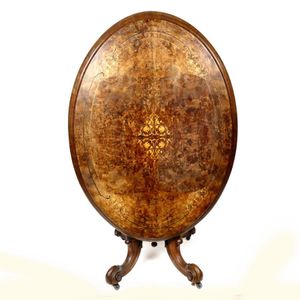Sheraton Tilt-Top Inlaid Table
You must be a subscriber, and be logged in to view price and dealer details.
Subscribe Now to view actual auction price for this item
When you subscribe, you have the option of setting the currency in which to display prices to $Au, $US, $NZ or Stg.
- Thomas Sheraton - Thomas Sheraton (1751-1806) was born in Stockton on Tees in the north of England. He was apprenticed to a local cabinetmaker and after working as a cabinetmaker, Sheraton moved to London about 1790. Although he described himself as a cabinet-maker, like Chippendale, no definite piece of furniture can be traced to him as maker. Nevertheless, he was immensely influential and in 1791-4 published his four volume book 'The Cabinet-Maker and Upholsterer's Drawing Book'. The books were used as source of design by the furniture-making trade , who often simplified or modified the designs to suit their own preferences. Sheraton furniture is marked by restraint and sophistication, elegance and discretion, though he also found time to invent fanciful combination furniture.
- Inlay - Decorative patterns inserted into the main body of a piece of furniture, generally in wood of contrasting colour and grain, though brass, ivory, ebony, shell and sometimes horn have been used. Inlay may consist of a panel of well figured timber inset into a cabinet door front, geometric patterns, or complex and stylized designs of flowers, swags of foliage, fruits and other motifs. As a general rule, in pieces where the carcase is constructed in the solid, the inlay is relatively simple such as stringing, cross banding and herringbone banding. Where more elaborate and decorative work was required veneer was used. Inlay has been fashionable from at least the latter half of the 17th century, when a variety of elaborate forms were developed
This item has been included into following indexes:
Visually similar items

A mid Victorian oval walnut loo table with figured veneered top, carved pedestal base. One caster damaged. Height 77 cm. Width 131 cm. Diameter 95 cm

A Victorian walnut loo table with quartered veeners and foliate satinwood inlay and stringing on a cathedral base. Some veneer damage. Height 690. Length 130 cm. Width 100 cm

A Victorian loo table, the highly figured oyster shell veneered oval top with fine satinwood inlays and ebony stringing, raised on an ornate cathedral base. Width 136 cm, depth 98 cm, height 760 mm.

A good quality Victorian figured walnut oval loo table, the quarter matched 'oyster shell' veneers with restrained classical inlay, raised on turned baluster column support with carved quadruped base and original white porcelain casters, 140 cm x 110 cm x
